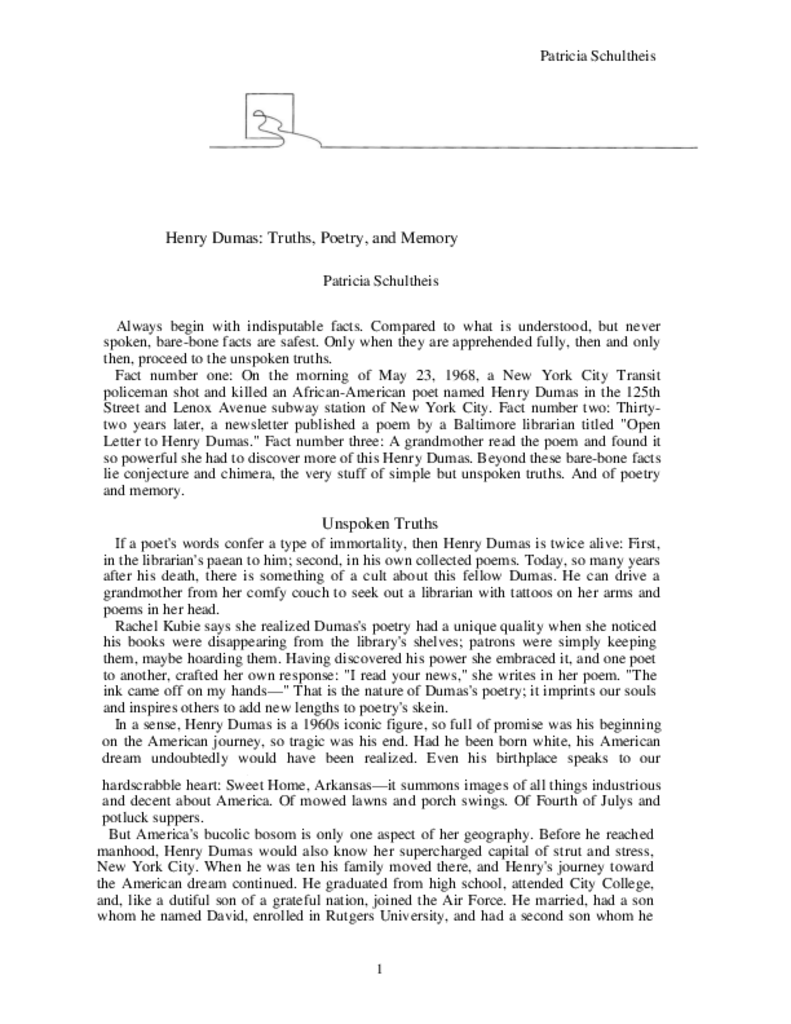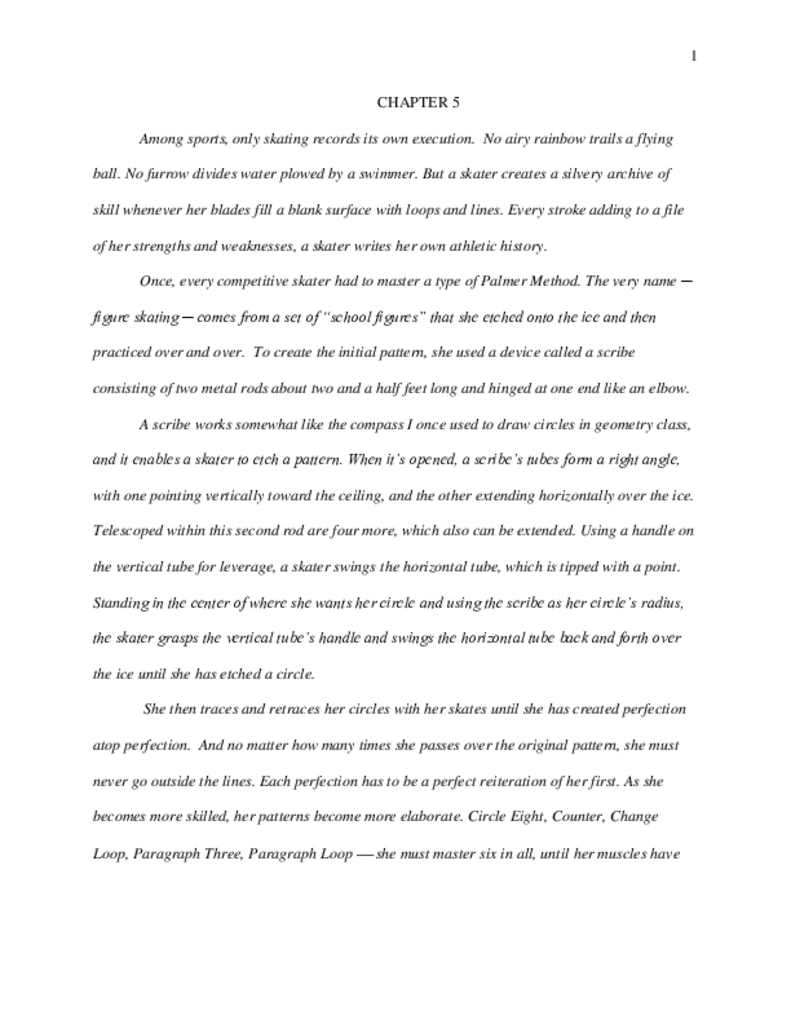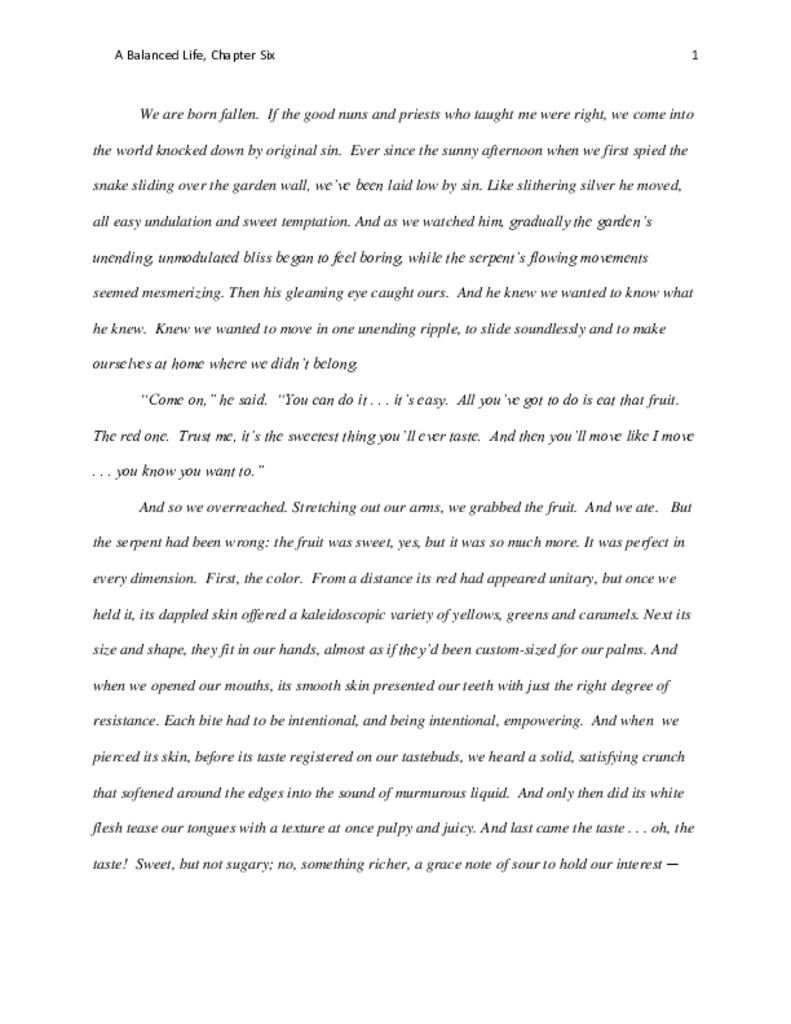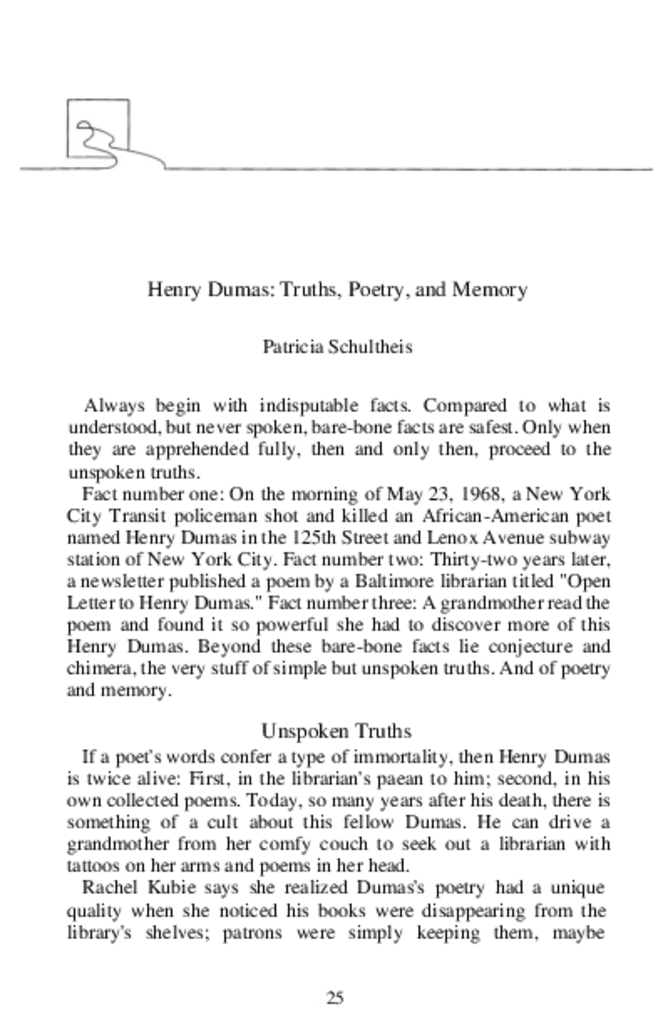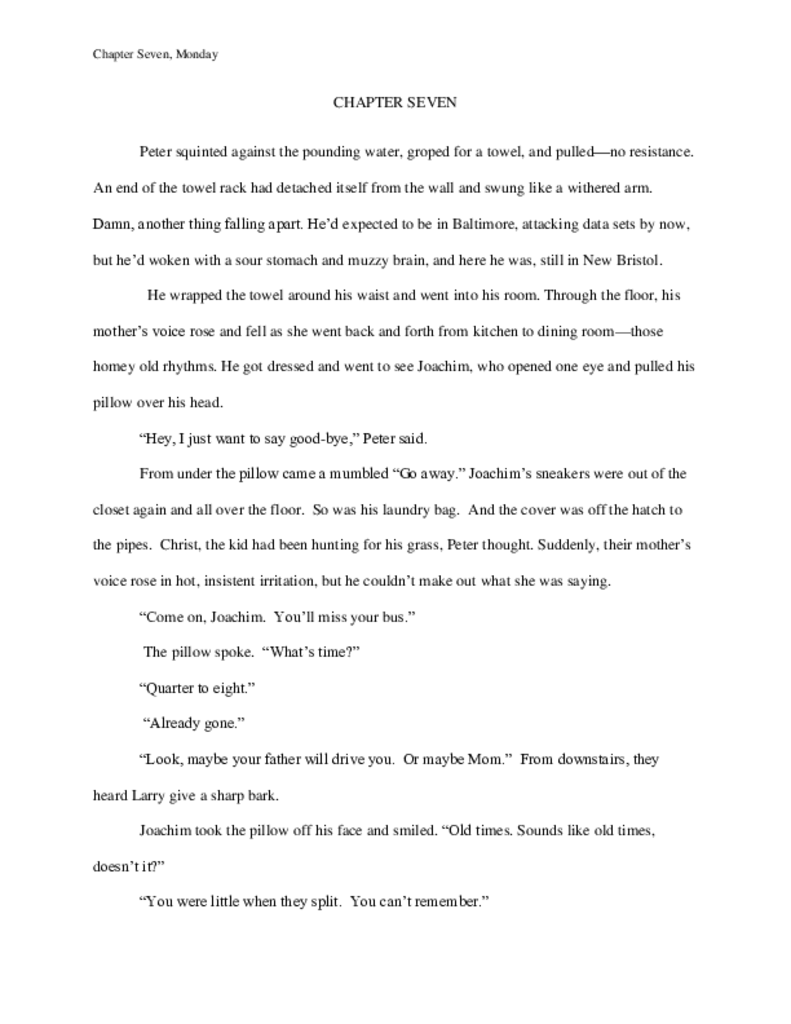Work samples
-
The Haint
I chose "The Haint" as the first story in St. Bart's Way, my award-winning story collection, because "The Haint" best illustrates the perfidious self-delusion upon which so much of the American dream is built. Before it was published in St. Bart's Way, "The Haint" was published in Left Curve. The sample submitted here is foreshortened; for the complete text of "The Haint" see my project titled St. Bart's Way.
-
A Balanced Life
A Balanced Life is a lyrical memoir that uses the sport of ice skating to explore loss, grief, and resilience. Beginning when I received a pair of second-hand skates when I was eleven years old, A Balanced Life traces how my love of skating remained a constant throughout my teenage years, and into new motherhood during the turbulent 60s and 70s and continuing through the early years of my widowhood. A Balanced Life was published by All Things That Matter Press in 2018.
-
Henry Dumas
This sample titled "Henry Dumas: Truths, Poetry and Memory" is an excerpt from a longer essay by the same title that was published in the Chattahoochee Review, Summer, 2005 issue, where it was a finalist for the nonfiction award. "Henry Dumas: Truths, Poetry and Memory" was inspired by a poem by Rachel Kubie that I read in a newsletter from the Enoch Pratt Free Library. To read the complete work, see "Henry Dumas: Truths, Poetry and Memory" in my project titled Published Essays.
-
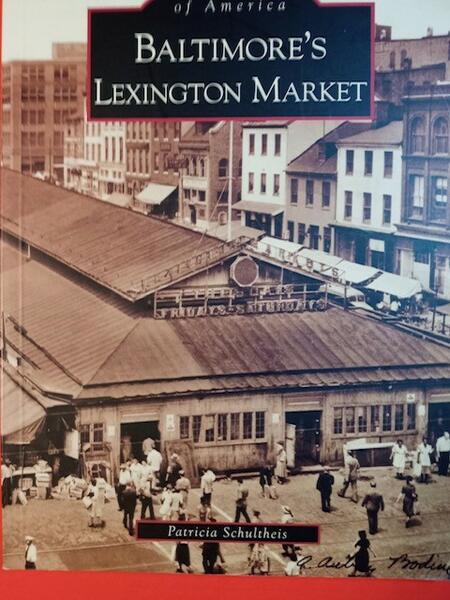 Lexington Market
Lexington MarketBaltimore’s Lexington Market, which was published in 2007, is the first book devoted solely to the market, a world-famous food emporium. It traces the market’s history from its founding more than 225 years ago to the present. The text accompanying the photos has been carefully researched and provides an overview of the market’s place in the history of Baltimore and the surrounding farming areas. Copies of the never- before published petitions establishing the market from the early 1800s are included as are many photographs from private collections that have never been seen before. Other photographs are from professional archival collections and represent the highest standards of the photographic arts. In writing the text, I made a deliberate effort to link the market to historical developments unfolding in the wider society. Many captions contain quotes from sources other than the subjects of the photographs and give readers an idea of how the market was regarded in past centuries. In other captions, rich, personal stories from past stall keepers give unique insight in the market’s day-to-day operations. In designing Baltimore’s Lexington Market, I took great care to create a harmonious and interesting visual presentation.
About Patricia

Alcoholism and polio; I had the latter and once knew a young man whose great promise was quashed by the latter.
Growing up in heavily industrial Bridgeport, Connecticut, during the 1950s, I lived in a Catholic cocoon of friends and classmates like myself, second- generation Americans who were expected to fulfill the aspirational dreams of their parents. … more
A Balanced Life, a memoir published by All Things That Matter Press
Synopsis
Growing up in a Polish-American household fraught with anxiety and aspirations, I seized upon skating’s promise of gracefulness as a means to transcend my own awkwardness and confusion. I remember the dreary Saturday afternoon when I was eleven years old, and my uncle Leo brought me a pair of skates my cousin Carolyn had outgrown — I felt like Cinderella must have when she slipped her foot into the glass slipper. The first time I used them my best friend, Sharon Ryan, broke her arm, but I was undeterred: when I skated I thought I was pretty. And if I was pretty I would be loved.
The story continues into my teens and college years, when sometimes I skated in the rink of Yale University hoping to attract a Yalie, while seriously neglecting my studies. Nor did I realize I was on the brink of emotional collapse.
The third chapter recounts the early years of my marriage, when I laced up the boots of my second-hand skates three or four times a winter, at a time when other women were pulling up their own boots and marching out their doors to the beat of women liberation anthems.
The essence of skating is mastery of edges (each blade has two). But, in another sense, we were all trying to gain the edge over the competition. When I gave myself the gift of skating lessons as a fortieth birthday present, I was trying to juggle marriage, children and a career. In short, I was trying to maintain my balance while holding my edge, an almost impossible situation, and the focus of the fourth chapter.
The term “figure skating” comes from the patterns skaters trace on the ice, and, in as much as, skating has predictable patterns, it represents a sort of grammatical athleticism. About the time my uncle gave me my first skates, I knew I had a propensity for words and found in grammar a satisfying anodyne for my chaotic family life. In my late thirties I began writing free-lance articles, an experience that released my inner eagle in a way that skating never could. The fifth chapter deals with my interest in writing and growth as a freelancer.
The sixth focuses on falling, as well as the price we pay for self-invention and overreaching our limits. The seventh deals with Olympians — twice I’ve had the privilege of being on the ice with Gold Medalists, and seeing them, and knowing their medals make them unique among us, the question arises: Was the price they paid for gold, worth it?
Skating’s grace derives from an absence: the absence of metal that has been ground out of the blade, creating two edges, with a hollow — an absence — between them. But what happens when absence, a negative, becomes the most real thing in your life? What happens when nothing in life touches you like the void in your heart when someone dies? These are the questions I explore in Chapter Eight, when my husband dies, and I doubt I can ever get up again, let alone skate
The final chapter deals with my returning to skating and my search for him among the stars on snowy nights. And my realization that ice is the midwife of life.
-
A Balanced Life, PrefaceA Balanced Life was published by All Things That Matter Press in 2018. In the Preface I describe how I first conceived of a memoir based on ice skating, a sport for which I have no ability, and how that conception changed over time as devasting losses buffetted me. In the Preface I also describe what skating taught me about my own weaknesses and resiliency.
St. Bart's Way, an award-winning story collection published by Washington Writers Publishing House and set in Baltimore
I didn’t begin to write fiction until my mid-fifties and had no guage as to whether or not I had any talent. Not before each of the 13 stories in St Bart’s Way was published in a literary review or journal (to find out where, see my resume) did I realize I had a thematically linked collection. I am very grateful to the editors of those journals and reviews for their support and encouragement and to Washington Writers’ Publishing House, which awarded St. Bart's Way its 2015 fiction award and for publishing these stories as a collection. That award had a profound impact on how I regarded myself as a writer; it affirmed my sense of my own talent and reinforced my commitment.
-
The HaintBefore it was published in St. Bart's Way, "The Haint" was published in Left Curve. The inspiration came from a display I saw in the Visionary Art Museum and from a rumor about a house in Dickeyville, where I lived for 22 years. I chose "The Haint" as the first story in my collection because it establishes the original sin underlying the St. Bart's community.
-
After the Service"After the Service" originally was published in The Distillery. I literally revised the opening 40 times in an attempt to establish the right tone. I remember looking out at the Gywnns Falls, which bordered my property, and suddenly hearing "Funny," and knowing how that single word expressed the conversational pitch I'd been was searching for. On the other hand, the final phrase, "Brothers in repose." came to me as I was making the bed.
-
The Crunch"The Crunch" originally was published in Potpourri in 2002. I rarely use real people for my characters, but I have to admit that Carla was inspired by someone I knew at the Community College of Baltimore, where I worked for several years. Gordy was inspired by a story a friend told me about a young man she knew. Further inspiration came from seeing a young medical student at the University of Maryland looking longingly at a street performer with glitter in her hair.
-
Abiding Blue VelvetAs an outsider, Baltimore's middle-class social mores have always fascinated me. "Abiding Blue Velvet," which originally was published in the Dalhousie Review, typifies the constraints individuals put on themselves in order not to violate those mores. Or to break someone's heart.
-
Other Men's SonsThe people living in the well-built homes surrounding St. Bart's Way have the expectation that their children will attain the same measure of scholastic and professional success that they have. "Other Men's Sons" explores what happens when those expectations are not met. "Other Men's Sons" originally was published in the Georgetown Review.
-
Bang!People choose to live in the community surrounding St. Bart's Way because they assume the neighborhood will shelter them from tensions and traumas affecting people living elsewhere in Baltimore. "Bang!", which explores the aftermath of a shooting at an exclusive prep school, demonstrates just how false that assumption is. "Bang" originally was published in Transcendent Visions and also was included in the anthology Lock & Load, published by The University of New Mexico Press in 2017.
-
Standards"Standards" originally was published in Scribble. An interviewer once asked me which among the stories in St. Bart's Way was my favorite, and I answered "That is like asking me which was my favorite child." But, if I'm going to be truthful, "Standards" is especially close to my heart, because it transpires in a morally ambiguous landscape, a landscape that is where, as I've come to believe as I've grown older, all adult humans eventually must live it they are to be true to themselves.
Published Essays
"Henry Dumas: Truths, Poetry and Memory," was a runner-up for nonfiction in a contest sponsored by the Chattahoochee Review in 2005; "Anonymous Told Me So" received an award from the League of American Pen Women, San Francisco Branch in 2011; and "Mort's Pen" received an award from the same organization in 2021. "Skating to Seventy" was the first place winner for nonfiction sponsored by Winning Writers in 2011.
Other Published Short Stories
Like those in St. Bart’s Road, all the stories in this project have been published or are forthcoming in a literary journal or review. They represent a diversity of settings and characters, ranging from an ex-con rehabbing a house to flip to a woman musing on decades of war.
As a writer, what is delicious to me about short stories is their intensity: every word, every punctuation mark matters. Moreover, every word, every punctuation mark serves only one purpose: the furtherance of the story. No extraneous details, dialogue, or descriptions are permitted, not if the result is to be a unified, satisfying whole.
Achieving that unity challenges the writer to pare her language and focus her attention on her story’s essence, something that may not become apparent until she’s well along, because the foundation of all literary fiction is a theme, issue, or universal question operating beneath the surface action. Within a few thousand words the writer much create a world that’s as confounding yet as believable as any her readers experience in their day-to-day lives. I hope that the stories included in this project are evidence that capability.
-
In the Ullage"In the Ullage" is the first of what I hope will be a collection of stories about Teddy, an alcoholic, and Teddy's family. "In the Ullage" was published in the Little Patuxent Review, Winter, 2022 issue. It won a fiction award from the 2021 Soul-Making Keats Contest sponsored by the League of American Pen Women, San Francisco Branch and was a finalist for the 2021 Tobias Wolff Award sponsored by the Bellingham Review.
-
The Ages of Juliette"The Ages of Juliette" is one of collection of short stories that I am writing about Teddy Holbrook, an alcoholic living in Baltimore, and his family. Juliette is Teddy's first child and eldest daughter. "The Ages of Juliette" is forthcoming in a future issue of the Woven Tale Press.
Book Reviews
As I mentioned in my Writing Samples, writing book reviews is different from writing fiction: it taps into a different area of my brain, presents different challenges, and calls for different energy. Whichever book I’m asked to review, I always read twice: once to follow the plot and characters as any reader would; and then a second time to takes notes about themes, structure, and technique.
Once I sit down to write, I’ve already determined my review’s basic structure and starred the quotes I want to use. And I write fairly quickly, a day or two at most. Also, I critique the work dispassionately. My job as a critic is not to evaluate a book's subject matter, but how well the author has addressed that subject matter, since subject matter can be influenced by society’s caprice, but good writing endures. Similarly, as I do with my short stories and essays, I strive to make certain that my reviews employ the tropes any writer has in her or his toolbox, such as alliteration, simile, and varied sentence structure.
-
Review of Nancy Hale: on the Life & Work of a Lost American MasterThis review of Nancy Hale: on the Life & Work of a Lost American Master, was published in the Chattahoochee Review , vol. xxxiii, Number 1, Spring 2013. Because I had trouble uploading it from the published online version, I've supplied a link. https://chattahoocheereview.gsu.edu/issue/volume-34-1
Op-ed and Opinion Pieces
When the Evening Sun folded, I focused my energy on writing feature articles, which were published in a variety of places. Not until I turned to writing fiction in my fifties did I resume writing op-ed pieces because op-ed pieces are akin to fiction in as much as they demand vivid scenes and allow for joining together seemingly disparate ideas. Unlike fiction, however, op-ed peices permit the writer’s personality to shine through. In fact, that is the essence of a good op-ed piece.
The topics included in this project range from the impact of political corruption to the Kentucky Derby. But taken together, they are representative of my opinions and passions.
Baltimore's Lexington Market
On a rainy evening in May of 2006, I received a five-word email message that literally changed my life. The email came Arcadia Publishing of South Carolina and it read: “Can you do Lexington Market?” Arcadia is a publisher of pictorial local histories, and in 2006 they were looking for Baltimore writers who would work according to Arcadia’s tight deadlines and strict requirements. Arcadia’s contracts required authors to obtain 140 photographs, write all text, and lay out their books according to Arcadia’s established formula.
And so began the most intense three months of my life. Writing Baltimore’s Lexington Market became an all-consuming task that demanded ferreting out sources of photos, cajoling their owners into letting me borrow them, or, in many cases paying to have them reproduced, and then grouping them into chapters to form an interesting narrative.
Writing Baltimore’s Lexington Market was challenging, but also satisfying. Many years later, I still feel privileged to have contributed to preserving the history of such a venerable Baltimore institution, and honored to have highlighted the entrepreneurial spirit of the market’s merchants. And I am grateful to Arcadia for introducing me to the ways of commercial publishing.
I apologize if the images I selected for this project are not as clear as one would wish.
-
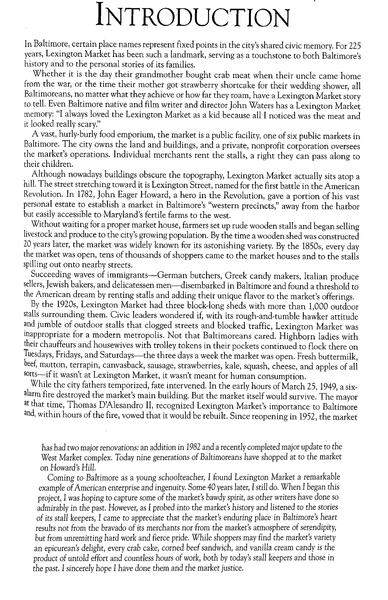 Schultheis, Patricia Scanned Documents-1.jpgSince I wrote this introduction to Baltimore's Lexington Market in 2006, the market has undergone yet another major renovation. I believe the market's continuing ability to reinvent itself testifies to its vitality and the place it holds in the hearts of Baltimoreans. This introduction was scanned directly from the printed page and I apologize for the lack of clarity.
Schultheis, Patricia Scanned Documents-1.jpgSince I wrote this introduction to Baltimore's Lexington Market in 2006, the market has undergone yet another major renovation. I believe the market's continuing ability to reinvent itself testifies to its vitality and the place it holds in the hearts of Baltimoreans. This introduction was scanned directly from the printed page and I apologize for the lack of clarity. -
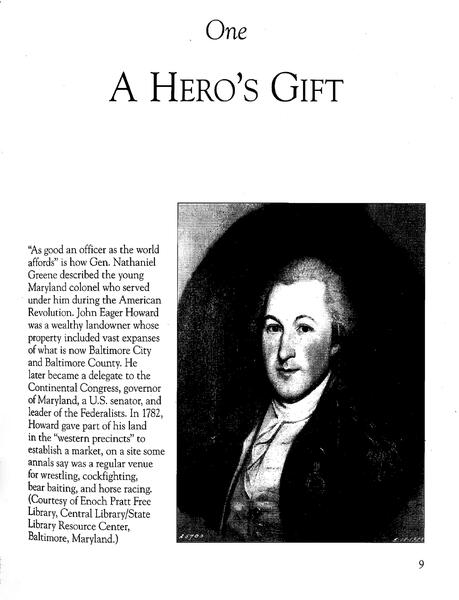 Schultheis, Patricia Scanned Documents-3.jpgFor 240 years Lexington Market has thrived on a slice of land given to the City of Baltimore by John Eager Howard, a hero of the American Revolution. Howard's intent was to lure Baltimore's center of commerce away from the harbor and toward the city's western precincts, where Howard himself owned farms. Before the market was established, local people used the site for bear-baiting.
Schultheis, Patricia Scanned Documents-3.jpgFor 240 years Lexington Market has thrived on a slice of land given to the City of Baltimore by John Eager Howard, a hero of the American Revolution. Howard's intent was to lure Baltimore's center of commerce away from the harbor and toward the city's western precincts, where Howard himself owned farms. Before the market was established, local people used the site for bear-baiting. -
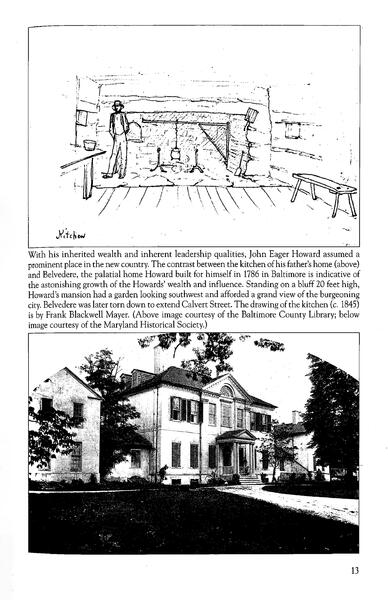 Schultheis, Patricia Scanned Documents-2.jpgI included the two pictures above in both Baltimore's Lexington Market and as part of this project to show the stark contrast in circumstances from one generation to another. The drawing above by Frank Blackwell Mayer is the home that John Eager Howard's father, Cornelius, built on Reisterstown Road. It also is where John Eager Howard was born. (This modest home was demolished in 1857.) The second picture is of Belvedere, the palatial home that John Eager Howard built for himself on Calvert Street. When the city fathers decided to extend Calvert Street, Belvedere, too, was demolished.
Schultheis, Patricia Scanned Documents-2.jpgI included the two pictures above in both Baltimore's Lexington Market and as part of this project to show the stark contrast in circumstances from one generation to another. The drawing above by Frank Blackwell Mayer is the home that John Eager Howard's father, Cornelius, built on Reisterstown Road. It also is where John Eager Howard was born. (This modest home was demolished in 1857.) The second picture is of Belvedere, the palatial home that John Eager Howard built for himself on Calvert Street. When the city fathers decided to extend Calvert Street, Belvedere, too, was demolished. -
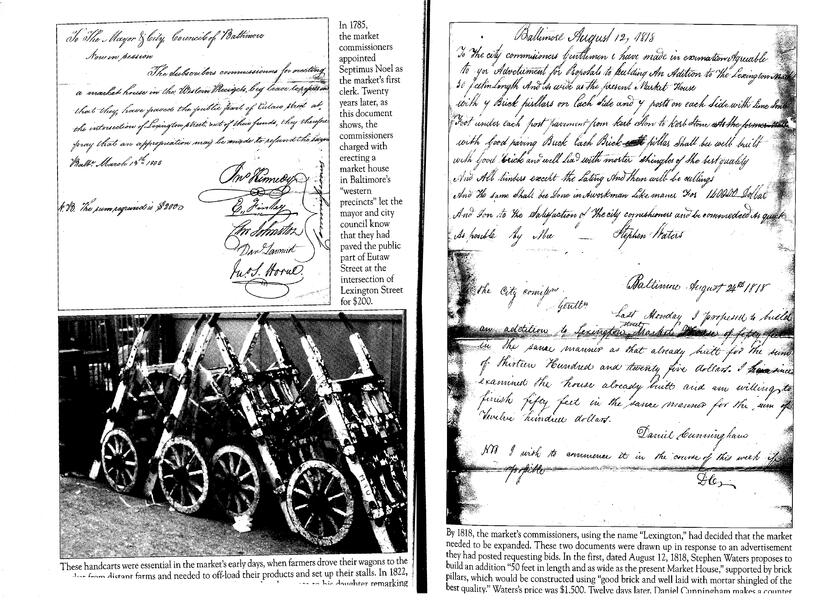 Schultheis, Patricia Scanned Documents-4.jpgOne of the challenges I faced in writing Baltimore's Lexington Market was Arcadia Publishing's requirement that the book contain 140 images. But the market was a well-established fixture of life in Baltimore long before the invention of photography, so how was I going to document those early years? Fortunately, I was able to scan some critical documents. The top-left image is of a 1805 document from the market's commissioners announcing that they had succeeded in paving Eutaw Street. The two documents on the right date from 1818. They are responses to the commissioners' requests for bids to construct a permanent structure. The handcarts on the lower left were for use by the farmers who drove their horse-drawn wagons from as far as Montgomery County to sell their wares at the market.
Schultheis, Patricia Scanned Documents-4.jpgOne of the challenges I faced in writing Baltimore's Lexington Market was Arcadia Publishing's requirement that the book contain 140 images. But the market was a well-established fixture of life in Baltimore long before the invention of photography, so how was I going to document those early years? Fortunately, I was able to scan some critical documents. The top-left image is of a 1805 document from the market's commissioners announcing that they had succeeded in paving Eutaw Street. The two documents on the right date from 1818. They are responses to the commissioners' requests for bids to construct a permanent structure. The handcarts on the lower left were for use by the farmers who drove their horse-drawn wagons from as far as Montgomery County to sell their wares at the market. -
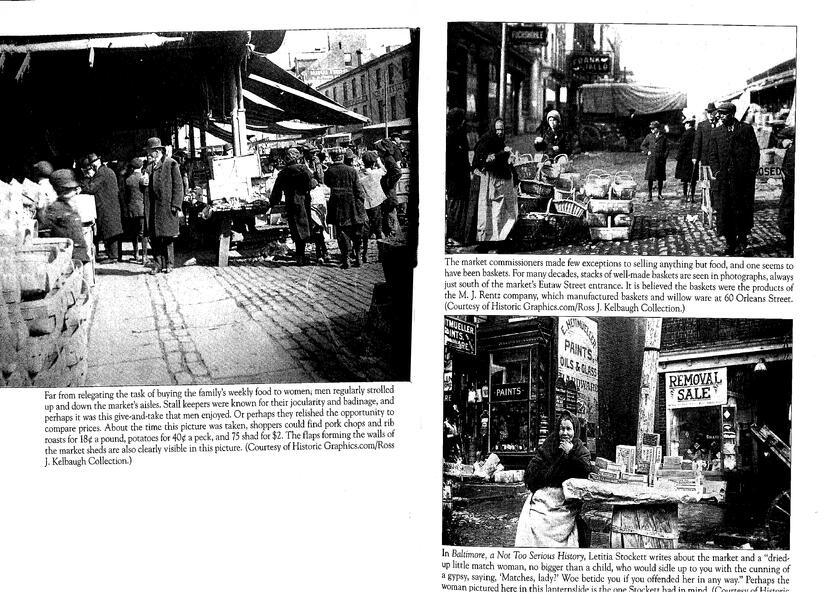 Schultheis, Patricia Scanned Documents-5.jpgThese three images came from lantern slides owned by the Ross J. Kelbaugh Collection, which I stumbled upon late into the project. However, I was so entranced by them that I altered to entire layout in order the include them. I felt these images were essential in order to show how all manner of Baltimoreans found something to relish at the market. The nattily dressed gentleman on the left seems as completely engrossed by what he sees as the throng of boys to his right. While the market restricted what merchants could sell to foodstuffs, an exception seems to have been made for the woman selling baskets, who appears in several photographs.
Schultheis, Patricia Scanned Documents-5.jpgThese three images came from lantern slides owned by the Ross J. Kelbaugh Collection, which I stumbled upon late into the project. However, I was so entranced by them that I altered to entire layout in order the include them. I felt these images were essential in order to show how all manner of Baltimoreans found something to relish at the market. The nattily dressed gentleman on the left seems as completely engrossed by what he sees as the throng of boys to his right. While the market restricted what merchants could sell to foodstuffs, an exception seems to have been made for the woman selling baskets, who appears in several photographs. -
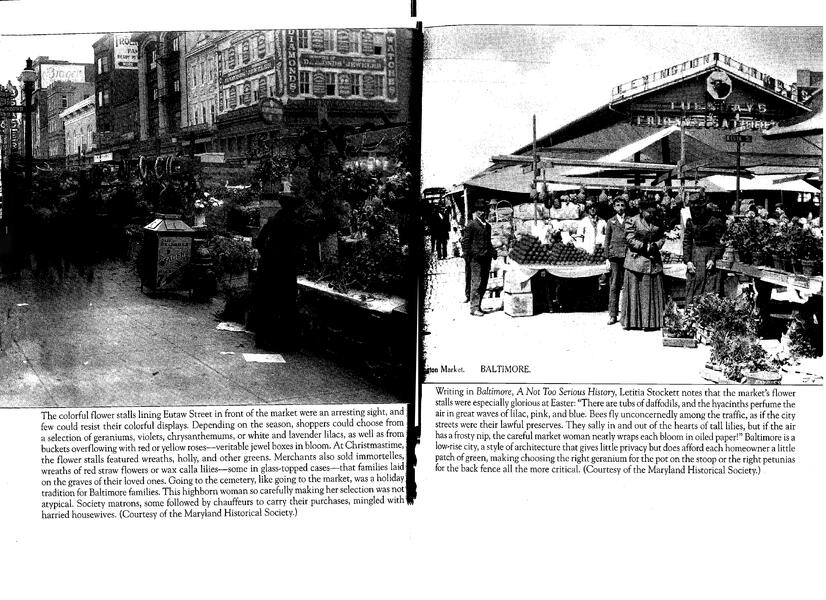 Schultheis, Patricia Scanned Documents-6.jpgThe flowers in these stalls lining Eutaw Street show the high standard of excellence that characterized the merchandise sold at Lexington Market. In the pediment of the shed shown on the right is a large medallion of a bull, an image the market adopted as its symbol.
Schultheis, Patricia Scanned Documents-6.jpgThe flowers in these stalls lining Eutaw Street show the high standard of excellence that characterized the merchandise sold at Lexington Market. In the pediment of the shed shown on the right is a large medallion of a bull, an image the market adopted as its symbol. -
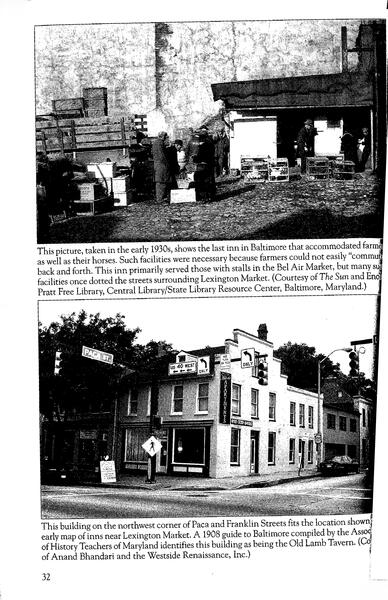 Schultheis, Patricia Scanned Documents-7.jpgWhile shoppers loved the market's hurly-burly atmosphere, having a stall there frequently demanded bone-crushingly hard work. The market was always intended as an outlet for farmers to sell directly to customers, a precursor to today's farm-to-table movement. But getting their merchandise to market demanded a lot from the farmers, some of whom came from as far away as Pennsylvania. As late as the 1930s, some farmers still didn't have trucks, so they got their products to the market by horse-drawn carriages. The top picture shows the last inn in Baltimore to accommodate both horses and their owners. The lower picture is of a building just up the road from Lexington Market on Eutaw Street. Its design is similar to the inn's above, although there is no record of the lower building ever having sheltered farmers and their horses.
Schultheis, Patricia Scanned Documents-7.jpgWhile shoppers loved the market's hurly-burly atmosphere, having a stall there frequently demanded bone-crushingly hard work. The market was always intended as an outlet for farmers to sell directly to customers, a precursor to today's farm-to-table movement. But getting their merchandise to market demanded a lot from the farmers, some of whom came from as far away as Pennsylvania. As late as the 1930s, some farmers still didn't have trucks, so they got their products to the market by horse-drawn carriages. The top picture shows the last inn in Baltimore to accommodate both horses and their owners. The lower picture is of a building just up the road from Lexington Market on Eutaw Street. Its design is similar to the inn's above, although there is no record of the lower building ever having sheltered farmers and their horses. -
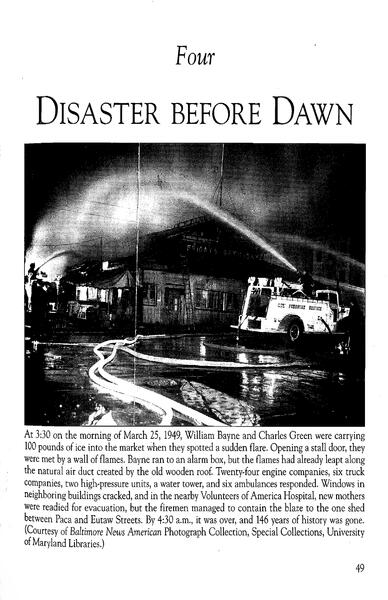 Schultheis, Patricia Scanned Documents-8.jpgIn the wee hours of March 25, 1949, disaster struck the market when a fire consumed one of the market's two ancient wooden sheds. The heat was so intense that the glass in the display cases burst and porcelain countertops cracked. Within a few hours 146 years of Baltimore history were erased.
Schultheis, Patricia Scanned Documents-8.jpgIn the wee hours of March 25, 1949, disaster struck the market when a fire consumed one of the market's two ancient wooden sheds. The heat was so intense that the glass in the display cases burst and porcelain countertops cracked. Within a few hours 146 years of Baltimore history were erased. -
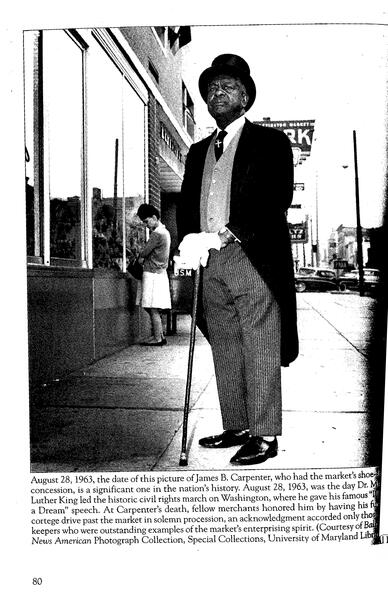 Schultheis, Patricia Scanned Documents-9.jpgFor many years James Carpenter, who had a shoe-shine stall in the market, dressed in formal wear every evening to ring the bell signaling that the market was closed for business. His fellow stall keepers so esteemed Carpenter that when he died, they invited his funeral cortege to pass in solemn procession before the market, an honor only accorded those merchants who best exemplify the market's enterprising spirit.
Schultheis, Patricia Scanned Documents-9.jpgFor many years James Carpenter, who had a shoe-shine stall in the market, dressed in formal wear every evening to ring the bell signaling that the market was closed for business. His fellow stall keepers so esteemed Carpenter that when he died, they invited his funeral cortege to pass in solemn procession before the market, an honor only accorded those merchants who best exemplify the market's enterprising spirit.
What Child Is This?
Summary of What Child Is This?
On the night Dr. Peter Farley returns to New Bristol, Pennsylvania, to celebrate his mother’s fiftieth birthday, his teenaged brother Joachim and Joachim’s best friend re-enact a horrific scene from American history and completely ruin the party. The next morning Peter discovers the friend’s body, and, when the police suspect Joachim, determines that he must discover the real killer.
The Bones of Two
THE BONES OF TWO
by
Patricia Schultheis, (410) 448-4211 [email protected]
The Bones of Two is a thriller, where every uncovered secret twists the plot tighter, and every plot twist propels the action and thrusts the characters into uncharted territory. The story takes place in the present, but its roots are in the seventies, an era of collective craziness, when the Weathermen set off bombs on college campuses, the National Guard massacred a student at Kent State, and the Manson family murders were fresh in the nation’s consciousness.
But all that unrest meant nothing to nine-year-old Douglas Gianni of Steubenville, Ohio. He’d had a great time at summer camp and was looking forward to finishing the plastic lanyards he made for his family when he got home. Only no one came to pick him up: not his mother; not his father; not his breathtakingly beautiful sister, Melissa.
Given the social upheaval of the times the police suspected that Melissa had killed her parents and ran away with Joey Kolpecki, the loser whose flashy red Firebird she’d been riding around in all summer. At least that was the assumption that Stan Petrovic, a veteran detective, and his inexperienced partner, Harry Specter, operated under until all their leads went cold.
Now, the excavation for a new gas pipeline has unearthed the bones of two: a man and a woman whose wedding bands identify them as Frank and Kathleen Gianni, Doug’s parents. A middle school vice-principal in Baltimore County with a wife and two grown children when his parents' remains are unearthed, Doug returns to Steubenville to bury them. But the trip plunges him into emotional turmoil, and he feels his carefully constructed, middle-class life crumbling. And worse, Doug feels the secret he’s been harboring for decades pushing to the surface. No one, not even his wife, knows that his beloved sister has been in contact with him. Never believing that Melissa had anything to with their parents’ disappearance, Doug becomes desperate to find her before the police do. His search takes him on an unexpected journey. He gains a truer understanding of the wealthy, influential uncle who adopted him, and of the thin veneer his own marriage has been operating under.
Just as intent to find Melissa as Doug, is aging Harry Specter, whose recent cancer diagnosis has made him regard finding Melissa Gianni as his last worthwhile piece of police work. But both Doug and Harry may be too late.
Ever since she left Steubenville as pregnant fifteen-year-old, Melissa’s been living in Bridgeport, Connecticut, under the protection of a mafiosi, the godfather of her long-dead husband. But the discovery of her murdered parents, which has its own mafia connection, has made Melissa radioactive—if the police find her, what other crimes will they uncover? What no-show construction contracts? What rigged property records? What compromised prison guards? Living a shadow life, Melissa finds, has cost her too much. The bones of her parents may have been silent, but they manage to tell her and her brother an unforgettable story.
The Bones of Two was a finalist for the 2020 Novel Slices Award and is represented by Victoria Skurnick of the Levine, Greenberg, Rostan Literary Agency.
-
Bones Chapt 10.pdfChapter Ten finds Doug back in Baltimore surrounded by his family, but their lack of true understanding about how the discovery of his parents' bones has impacted him makes him impatient with them. Even his grandson annoys him until autistic Timmy discovers a clue in a missal Doug's mother sent him when he was away in summer camp.


